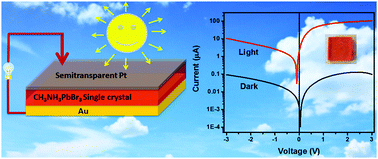Schottky junctions on perovskite single crystals: light-modulated dielectric constant and self-biased photodetection†
Abstract
Schottky junctions formed between semiconductors and metal contacts are ubiquitous in modern electronic and optoelectronic devices. Here we report on the physical properties of Schottky-junctions formed on hybrid perovskite CH3NH3PbBr3 single crystals. It is found that light illumination can significantly increase the dielectric constant of perovskite junctions by 2300%. Furthermore, such Pt/perovskite junctions are used to fabricate self-biased photodetectors. A photodetectivity of 1.4 × 1010 Jones is obtained at zero bias, which increases to 7.1 × 1011 Jones at a bias of +3 V, and the photodetectivity remains almost constant in a wide range of light intensity. These devices also exhibit fast responses with a rising time of 70 μs and a falling time of 150 μs. As a result of the high crystal quality and low defect density, such single-crystal photodetectors show stable performance after storage in air for over 45 days. Our results suggest that hybrid perovskite single crystals provide a new platform to develop promising optoelectronic applications.


 Please wait while we load your content...
Please wait while we load your content...